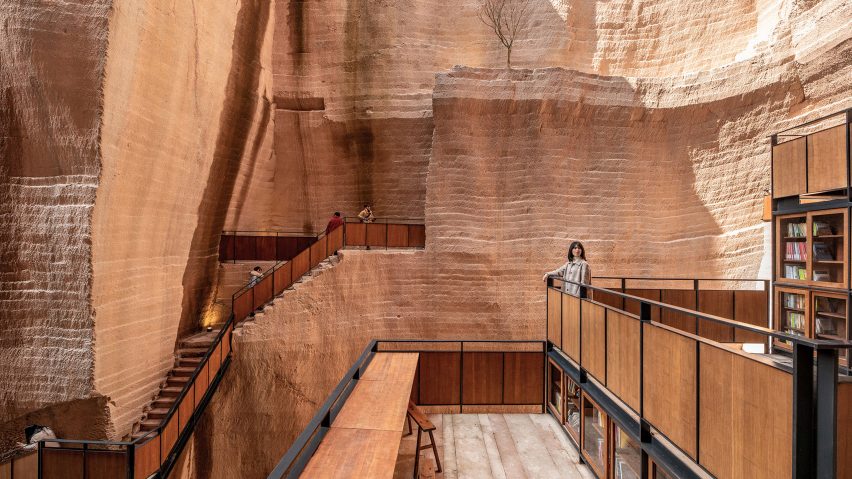Chinese studio DnA_Design and Architecture has transformed a series of former stone quarries in Zhejiang Province into cultural spaces, making sensitive insertions into their grand hand-carved interiors.
The abandoned quarries, which are among the thousands located in China's Jinyun county, have been converted into facilities for locals and tourists as part of a broader project to regenerate the area.
Beijing-based DnA_Design and Architecture was commissioned to transform nine of the excavated pits, three of which are now complete.
These three spaces provide a library, performance venue and area for gathering.
Drawing on the rich history of monuments and rock inscriptions in the region, the studio focused on highlighting the existing character of the quarries as much as possible.
According to the studio, this also challenges the "over-designing" of popular tourist areas in rural China.
"The project is an ecological improvement to mend the interrupted nature," the studio told Dezeen. "The reuse of these abandoned quarries reconnects the local community with its thousand-year history and heritage."
"The project is a rather minimal intervention, a micro-renovation and upgrade, addressing the possibility of spatial transformation of different quarries," the studio continued.
Each quarry features a distinctive form and patterns as a result of having been largely excavated by hand, which informed their designs as pieces of "public infrastructure".
The first space, named Quarry 8, has been turned into an open library. Its existing stone platforms have been retained and adapted with new concrete steps and seating areas made from steel and pressed bamboo.
Cabinets containing books have been built into the large steps of the quarry, with its tapering form creating naturally sheltered areas for reading.
"Each platform is a multicultural study where one can read, practice calligraphy from stone rubbings and, in the future, access e-books," said the studio.
The second pit, Quarry 9, is used as a performance space thanks to the acoustic properties of its tapering, cavernous form. A flat stone stage and sunken seating area have been added at its base.
Quarry 10, the third space, has been transformed into an area for demonstrating the process of stone quarrying. It features a stepped seating area and wooden details that unify it with the other facilities.
Across all three spaces, artificial lighting has been used to highlight the irregular shapes and markings across the stone surfaces.
In addition to the further development of the area's other quarries, there are also plans for an information centre to be built on a path that forms a scenic route between all of the new spaces.
"The first three quarries have already raised attention and discussion on the reuse of abandoned mines and quarries," reflected the studio.
"The project can be considered as a response to our current dilemma and a new way of thinking about our public life."
DnA_Design and Architecture was founded by Xu Tiantian in 2004 in Beijing. In the nearby county of Songyang, the studio recently carried out another rural regeneration project, creating a wooden tofu factory.
Elsewhere in China, architecture studio Jade + QA completed the Shimao Wonderland Intercontinental hotel within an 88-metre-deep abandoned quarry near Shanghai.
The photography is by Wang Ziling, courtesy of DnA_Design and Architecture.
Dezeen is on WeChat!
Click here to read the Chinese version of this article on Dezeen's official WeChat account, where we publish daily architecture and design news and projects in Simplified Chinese.

